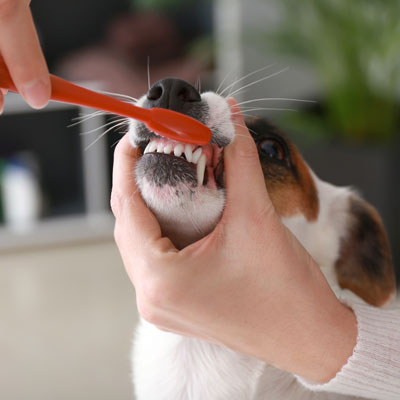Last Updated on May 4, 2024 by Dr. Alisha Barnes

Often, the link between our dogs’ bright, bounding energy and their dental health remains a mystery unseen beneath those playful fetches and contented tail wags. But the truth is, dental health is far from a mundane canine concern – it’s the silent sentinel to your furry friend’s overall well-being. Here’s why dog owners ought to bite into this crucial aspect of pet care.
Understanding the Canine Toothscape
The anatomy of a dog’s teeth is a fascinating subject. With a total of 42 teeth, compared to our 32, dogs are naturally equipped to rip, tear, and chew. However, unlike wild canines whose diet and lifestyle keep dental woes at bay, companion dogs face a modern oral health nemesis: plaque and tartar.
The Terrors of Tartar
Plaque, a biofilm of bacteria and saliva, is the culprit behind most dental issues in dogs. When left unchecked, plaque hardens to form tartar, leading to gingivitis, tooth decay, and periodontal disease. This isn’t just a cosmetic issue – the implications can be far-reaching and affect overall health.
Tackling Tartar at Home
Daily dental care for dogs should be a doggone priority for all pet parents. Maintaining a dental care routine at home can stave off a host of health problems down the line. But what exactly does this entail?
Creating Canine Dental Routines
- Brushing daily with a dog-friendly toothpaste and toothbrush
- Providing dental chews and toys designed to reduce plaque
- Using water additives that fight bacteria and freshen breath
- Regular dental check-ups, at least annually, with professional scaling and polishing as needed
Adhering to these routines not only keeps Fido’s breath fresh but provides a profound protection against systemic health issues.
The Big Picture: Dental Health and Canine Wellness
The heart, kidneys, and joint health are not sprawling leaps away from your dog’s oral health. In fact, the state of a canine’s teeth can tell quite the tale about internal health.
The Heartbeat Connection
Studies show that bacteria from periodontal disease can enter the bloodstream, potentially leading to heart infections, endocarditis, or other cardiovascular issues. A dog’s hearty smile might just indicate a healthy heart too.
Clearing the Air on Kidney Health
In advanced cases of dental neglect, the kidneys aren’t in the clear either. Chronic oral infections have been linked to kidney disease, given that they’re filtering the same infected blood.
Joints and Jaw Health
Sore gums and teeth from dental issues can lead to changed chewing habits, favoring one side or avoiding hard foods altogether. Over time, this can cause a misalignment in the temporomandibular joint, which can lead to chronic pain and affect mobility.
Recognizing the Signs of Oral Distress
Dog stoicism often belies their discomfort. Recognizing the signs of dental pain or disease is crucial for prompt treatment.
Watchful Canine-parent Eyes
- Foul breath: An unpleasant odor, more than just typical “dog breath,” can be a sign of an issue.
- Drooling: Excessive drooling without explanation could signal a problem.
- Red or bleeding gums: Bleeding during chew time is worrisome.
- Yellow-brown tartar: Visible plaque and tartar are stages on the road to more severe dental issues.
- Changes in eating or chewing habits: Reluctance to eat certain foods or chewing on one side only.
Professional Pet Dental Care: The Paws and the Professionals
Just as annual checkups are part of the human health regimen, so too should they be for your dog. Vets are trained to detect and address dental issues early.
Dentistry with a Wag
- Routine dental exams: Catching issues early can save both dental health and your wallet from major treatments.
- Professional cleaning: Scaling and polishing are essential to a comprehensive oral health plan.
- X-rays and dental surgery: In extreme cases, deeper procedures might be required, but they’re crucial for maintaining the quality of your pet’s life.
A Bone to Pick with Plaques
The importance of canine dental health cannot be overstated. From the heart to the joints, teeth can be a direct conduit to systemic ailments. By making tooth-care part of a pet’s daily routine, owners are investing in a longer, healthier life for their four-legged friends.
Dr. Alisha Barnes’s Unique Take on Dog’s Bone Health
While Dr. Alisha Barnes isn’t a veterinarian specializing in dental care, her unique approach to pet health, particularly spine and joint health, offers an insightful parallel. Just as dental hygiene is vital for overall canine health, ensuring their spine and joints are in good condition can prevent a myriad of health concerns.
The Role of a Pet Chiropractor in Canine Health
A pet chiropractor is a professional who specializes in the care of animals’ musculoskeletal systems, focusing primarily on the spine. Qualified through extensive training and certification to work with pets, these chiropractors apply adjustments to the vertebrae of the spine and joints to ensure proper alignment. This practice is grounded in the belief that many health issues in pets, including dogs, stem from the misalignment of the spine (subluxations), which can interfere with the nervous system and hinder the body’s innate ability to heal itself.
Unleashing the Benefits of Chiropractic Care for Dogs
Chiropractic care for dogs offers a non-invasive, drug-free option for pet owners looking to enhance their dog’s quality of life. Here are several benefits:
- Improved Mobility: Regular chiropractic adjustments can help older dogs maintain better mobility and reduce the risk of injury by ensuring joints are moving freely. This can be particularly beneficial for breeds prone to hip dysplasia and other joint issues.
- Pain Relief: Dogs suffering from conditions like arthritis or spinal issues can experience significant pain relief through chiropractic care, which helps to alleviate pressure on the affected nerves and tissues.
- Enhanced Performance: For working dogs or pets involved in agility and sports, chiropractic adjustments can optimize performance by maintaining peak physical condition.
- Supports Post-Surgery Recovery: Chiropractic care can aide in a smoother and quicker recovery post-surgery by ensuring the spine is correctly aligned for optimal nerve function throughout the healing process.
- General Wellness and Prevention: Even in the absence of noticeable symptoms, regular chiropractic care can maintain your dog’s overall health by supporting the nervous system’s optimal function, potentially preventing future ailments.
By aligning with a holistic approach to wellness, the integration of chiropractic care into a dog’s health regimen underscores the importance of preventative care and the pursuit of a harmonious balance within the body’s systems.
Enhancing the Spine for a Tail-Wagging Life
Dr. Barnes’s practice focuses on chiropractic care for pets, understanding that the spine is a crucial hub for a dog’s nervous system and general health. By optimizing spine health, she promotes wellness from the inside out, ensuring each wag is a sign of vitality.
Raising the Bark on Canine Health
With the evidence clear – dental health has a profound impact on a dog’s life – the onus is on dog owners to not just bark about pet care but to bite into their responsibility to care for their pets’ teeth. By treating dental health as a core component of overall wellness, pet parents can ensure that each bark, each stroll, and each playful romp is an expression of vibrant health.
For more insights on preserving your dog’s bone health, consider reaching out to experts like Dr. Alisha Barnes and build a comprehensive plan that extends beyond preventing toothaches and maintains a lifelong standard of care for your beloved pet. Remember, a healthy dog is a happy dog, and their smile is the purest reflection of that joy.
